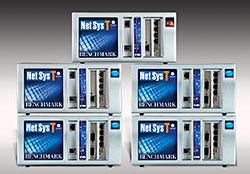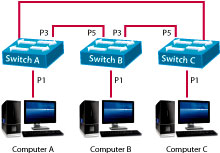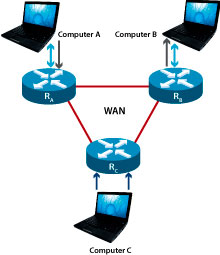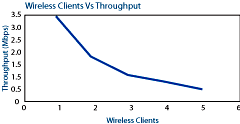NETWORK SYSTEMS LAB TRAINER
 Between two end PCs in a WAN or between a user and a server in the internet, there lies a vast list of equipment such as switchers, routers, firewalls, IDSs, etc., all working 24 hours a day, seven days a week and following various disparate technologies such as Ethernet, WLAN, E1/T1, DSL, SDH, FDDI, ATM, etc.; and, all aimed at ensuring that the end systems or users send and receive their required data without any loss, disruption or hassle.
Between two end PCs in a WAN or between a user and a server in the internet, there lies a vast list of equipment such as switchers, routers, firewalls, IDSs, etc., all working 24 hours a day, seven days a week and following various disparate technologies such as Ethernet, WLAN, E1/T1, DSL, SDH, FDDI, ATM, etc.; and, all aimed at ensuring that the end systems or users send and receive their required data without any loss, disruption or hassle.
 Understanding how the entire system works seamlessly in the network is always a thrilling experience for students. The Benchmark NetSys-T – Network Systems Lab – brings this system-level experience to users in a lab environment. Diffusing boundaries between voice and data, wired and wireless, LAN and WAN etc., the Benchmark NetSys-T helps its users to get the feel of a realistic end-to-end network service in a lab environment.
Understanding how the entire system works seamlessly in the network is always a thrilling experience for students. The Benchmark NetSys-T – Network Systems Lab – brings this system-level experience to users in a lab environment. Diffusing boundaries between voice and data, wired and wireless, LAN and WAN etc., the Benchmark NetSys-T helps its users to get the feel of a realistic end-to-end network service in a lab environment.
- Backbone realization using IP routers
- Wired LAN realization using HUB, Layer 2 & Layer 3 switches, Firewall
- Wireless LAN realization using Access points
- Throughput measurement using file transfer in shared and switched connectivity with Hub and switch respectively

- Observe MAC table formation in switches
- Create loop conditions and observe loop prevention in spanning tree protocol (STP)
- Establish a WAN connectivity with 3 routers and demostrate:
- Measure throughput using FTP sessions – under background traffic
- Convergence time
 Network access control in a LAN/WAN network using L3 switch & router
Network access control in a LAN/WAN network using L3 switch & router
- Implement a security policy in a LAN connected to a WAN-Intra-LAN security and WAN/LAN security
- Measure the radiation pattern of a given access point and suggest a optimum location for the access point
- Measure the throughput with more number of nodes participation in the WLAN and plot the curve

- Protocol : RIPV2.0, OSPFV4'
-
WAN Ports :
1.NetSys-T RTR-SFE model:
- a, Serial ports – 2 (RS232 upto 1Mbps)
- b, Fast Ethernet ports – 1
- Management Port : One Fast Ethernet port for device management and protocol packets monitoring
- LAN Ports : Fast Ethernet ports – 4
- Equipment Management & User Interface : Web browser access for ports configuration, device restart, shutdown, Protocol parameters configuration, Routing Table information – periodic update (every 3 or 1 sec), table saving
- Ports:
-
1.Firewall Mode
- a, Outside network – 1 Fast Ethernet.
- b, DMZ – 1 Fast Ethernet.
- c, Inside network – 4 LAN ports.
-
2.L3 Mode
- a, Outside network – 1 Fast Ethernet.
- b, Inside network – 1 Fast Ethernet and 4 LAN ports.
-
3.Management
- a, One Fast Ethernet port for device management.
- b, VLAN Support : Tag based VLAN.
- c, User Writable Rules : IPTables rules, NAT/PAT Address translation, Packet filtering.
- D, Equipment Management & User Interface : Web browser access for ports configuration, device restart, shutdown, user written rules update, current active rules information display and saving.
- MAC Address Table.
- Rapid Spanning Tree.
- Port, Tag Based VLAN.
- Equipment Management :Web browser access for VLAN assignment, device reset, MAC table observation.
- 802.11b/g
- Repeater Mode Operation
- Variable Power and Channel Selection
- Transmit Power : +14dBm
- Receiver Sensitivity : -66dBm for 54Mbps
- Coverage Area : Indoor upto 100m depending on the obstacles
